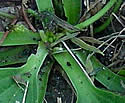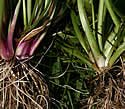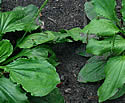Plantago major (Common Plantain)
| Also known as: | Broad-leaf Plantain |
|---|---|
| Genus: | Plantago |
| Family: | Plantaginaceae (Plantain) |
| Life cycle: | perennial |
| Origin: | Europe, Asia |
| Status: |
|
| Habitat: | part shade, sun; fields, woods, lawns, waste areas, disturbed sites |
| Bloom season: | June - October |
| Plant height: | 4 to 16 inches |
| Wetland Indicator Status: | GP: FAC MW: FAC NCNE: FACU |
| MN county distribution (click map to enlarge): |  |
| National distribution (click map to enlarge): |  |
Pick an image for a larger view. See the glossary for icon descriptions.
Detailed Information
Flower: 

![[photo of magnified flowers]](/udata/r9ndp23q/pd/plantago-major-850-7-t.jpg) Pencil-thin spike up to 10 inches long at the end of a smooth to slightly hairy but otherwise naked stem. Flowers are inconspicuous but for the extended purplish-tipped stamens and filament-like styles, densely arranged along a tall, narrow, green spike. The 4 triangular petals are papery, light brown, spreading or reflexed back at the tip of the larger egg-shaped calyx. Thick, green, lance-oval shaped sepals and a similar sized keel-like bract are at the base. A plant typically has several flowering stems, sprouting up in succession.
Pencil-thin spike up to 10 inches long at the end of a smooth to slightly hairy but otherwise naked stem. Flowers are inconspicuous but for the extended purplish-tipped stamens and filament-like styles, densely arranged along a tall, narrow, green spike. The 4 triangular petals are papery, light brown, spreading or reflexed back at the tip of the larger egg-shaped calyx. Thick, green, lance-oval shaped sepals and a similar sized keel-like bract are at the base. A plant typically has several flowering stems, sprouting up in succession.
Leaves and stems: 

![[photo of leaves]](/udata/r9ndp23q/pd/plantago-major-798-t.jpg) Leaves form a large basal rosette, mature leaves up to 11 inches long including the stalk, the blade oval-elliptic, to 6 inches long and 3¼ inches wide. The stalk is about ¼ inch in diameter at the base and typically colored green but for a hint of red at times.
Leaves form a large basal rosette, mature leaves up to 11 inches long including the stalk, the blade oval-elliptic, to 6 inches long and 3¼ inches wide. The stalk is about ¼ inch in diameter at the base and typically colored green but for a hint of red at times.
![[photo of leaf hairs]](/udata/r9ndp23q/pd/plantago-major-89370983-3-t.jpg) Young leaves may have inconspicuous hairs, especially towards the base, but at maturity surfaces are leathery and hairless, wavy and toothless or irregularly toothed around the edges, and with up to 5 conspicuous palmate veins on the lower surface. Flowering stems are usually erect.
Young leaves may have inconspicuous hairs, especially towards the base, but at maturity surfaces are leathery and hairless, wavy and toothless or irregularly toothed around the edges, and with up to 5 conspicuous palmate veins on the lower surface. Flowering stems are usually erect.
Fruit: 
![[photo of fruit]](/udata/r9ndp23q/pd/plantago-major-809-1-t.jpg) Fruits are rounded, egg shaped capsules about 1/8 inch long with light brown seeds inside. The capsule splits open around the middle.
Fruits are rounded, egg shaped capsules about 1/8 inch long with light brown seeds inside. The capsule splits open around the middle.
Notes:
Long a target of wrath by weed-free blue grass lawn lovers, Common Plantain is not alone in its guilt, sharing the honor/blame with the native Rugel's Plantain (Plantago rugelii). Both species persist well under frequent mowing and even seem to thrive in compacted soils along foot paths and driveway margins. While the non-native species is generally smaller at maturity in both flower spike height and leaf size, under heavy mowing that limits maturation the two look nearly identical at a casual glance. The easiest way to distinguish the two is by Common Plantain's green leaf stalk (Rugel's is purplish at the base), its nearly perfect egg-shaped seed capsules (Rugel's are more slender) and brown seeds (Rugel's are black). Also of note is Rugel's Plantain's leaves appearing heavily pleated as they emerge from the rosette whereas the non-native's do not. Leaves of both P. major and P. rugelii are edible, cooked or as salad greens.
Native Plant Nurseries, Restoration and Landscaping Services ↓
More photos
 Common Plantain plant in a no-mow area
Common Plantain plant in a no-mow area Common Plantain in pavement cracks
Common Plantain in pavement cracks fruit comparison of Plantago major and Plantago rugelii
fruit comparison of Plantago major and Plantago rugelii root comparison of Plantago major and Plantago rugelii
root comparison of Plantago major and Plantago rugelii basal rosette comparison of Plantago major and Plantago rugelii
basal rosette comparison of Plantago major and Plantago rugelii
Photos courtesy Peter M. Dziuk taken in Ramsey County.
Comments
Have you seen this plant in Minnesota, or have any other comments about it?
on: 2018-07-20 15:06:53
in the lawn
on: 2020-07-27 19:35:43
Does Plantago rugelii have the same itch relieving effect as Plantago major?






